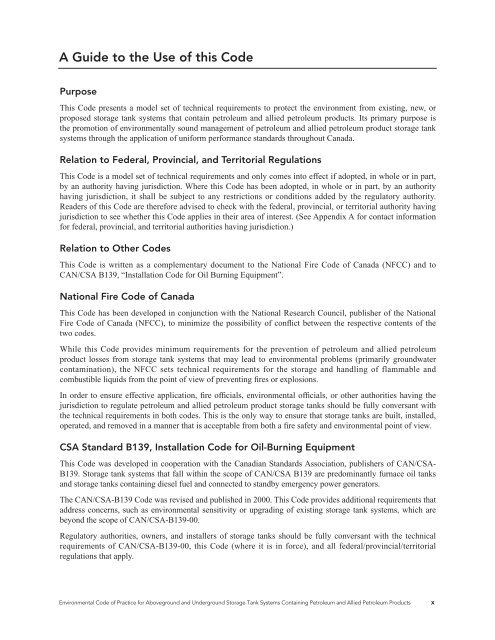Environmental Code of Practice for Aboveground and ... - CCME
Environmental Code of Practice for Aboveground and ... - CCME
Environmental Code of Practice for Aboveground and ... - CCME
You also want an ePaper? Increase the reach of your titles
YUMPU automatically turns print PDFs into web optimized ePapers that Google loves.
A Guide to the Use <strong>of</strong> this <strong>Code</strong><br />
Purpose<br />
This <strong>Code</strong> presents a model set <strong>of</strong> technical requirements to protect the environment from existing, new, or<br />
proposed storage tank systems that contain petroleum <strong>and</strong> allied petroleum products. Its primary purpose is<br />
the promotion <strong>of</strong> environmentally sound management <strong>of</strong> petroleum <strong>and</strong> allied petroleum product storage tank<br />
systems through the application <strong>of</strong> uni<strong>for</strong>m per<strong>for</strong>mance st<strong>and</strong>ards throughout Canada.<br />
Relation to Federal, Provincial, <strong>and</strong> Territorial Regulations<br />
This <strong>Code</strong> is a model set <strong>of</strong> technical requirements <strong>and</strong> only comes into effect if adopted, in whole or in part,<br />
by an authority having jurisdiction. Where this <strong>Code</strong> has been adopted, in whole or in part, by an authority<br />
having jurisdiction, it shall be subject to any restrictions or conditions added by the regulatory authority.<br />
Readers <strong>of</strong> this <strong>Code</strong> are there<strong>for</strong>e advised to check with the federal, provincial, or territorial authority having<br />
jurisdiction to see whether this <strong>Code</strong> applies in their area <strong>of</strong> interest. (See Appendix A <strong>for</strong> contact in<strong>for</strong>mation<br />
<strong>for</strong> federal, provincial, <strong>and</strong> territorial authorities having jurisdiction.)<br />
Relation to Other <strong>Code</strong>s<br />
This <strong>Code</strong> is written as a complementary document to the National Fire <strong>Code</strong> <strong>of</strong> Canada (NFCC) <strong>and</strong> to<br />
CAN/CSA B139, “Installation <strong>Code</strong> <strong>for</strong> Oil Burning Equipment”.<br />
National Fire <strong>Code</strong> <strong>of</strong> Canada<br />
This <strong>Code</strong> has been developed in conjunction with the National Research Council, publisher <strong>of</strong> the National<br />
Fire <strong>Code</strong> <strong>of</strong> Canada (NFCC), to minimize the possibility <strong>of</strong> conflict between the respective contents <strong>of</strong> the<br />
two codes.<br />
While this <strong>Code</strong> provides minimum requirements <strong>for</strong> the prevention <strong>of</strong> petroleum <strong>and</strong> allied petroleum<br />
product losses from storage tank systems that may lead to environmental problems (primarily groundwater<br />
contamination), the NFCC sets technical requirements <strong>for</strong> the storage <strong>and</strong> h<strong>and</strong>ling <strong>of</strong> flammable <strong>and</strong><br />
combustible liquids from the point <strong>of</strong> view <strong>of</strong> preventing fires or explosions.<br />
In order to ensure effective application, fire <strong>of</strong>ficials, environmental <strong>of</strong>ficials, or other authorities having the<br />
jurisdiction to regulate petroleum <strong>and</strong> allied petroleum product storage tanks should be fully conversant with<br />
the technical requirements in both codes. This is the only way to ensure that storage tanks are built, installed,<br />
operated, <strong>and</strong> removed in a manner that is acceptable from both a fire safety <strong>and</strong> environmental point <strong>of</strong> view.<br />
CSA St<strong>and</strong>ard B139, Installation <strong>Code</strong> <strong>for</strong> Oil-Burning Equipment<br />
This <strong>Code</strong> was developed in cooperation with the Canadian St<strong>and</strong>ards Association, publishers <strong>of</strong> CAN/CSA-<br />
B139. Storage tank systems that fall within the scope <strong>of</strong> CAN/CSA B139 are predominantly furnace oil tanks<br />
<strong>and</strong> storage tanks containing diesel fuel <strong>and</strong> connected to st<strong>and</strong>by emergency power generators.<br />
The CAN/CSA-B139 <strong>Code</strong> was revised <strong>and</strong> published in 2000. This <strong>Code</strong> provides additional requirements that<br />
address concerns, such as environmental sensitivity or upgrading <strong>of</strong> existing storage tank systems, which are<br />
beyond the scope <strong>of</strong> CAN/CSA-B139-00.<br />
Regulatory authorities, owners, <strong>and</strong> installers <strong>of</strong> storage tanks should be fully conversant with the technical<br />
requirements <strong>of</strong> CAN/CSA-B139-00, this <strong>Code</strong> (where it is in <strong>for</strong>ce), <strong>and</strong> all federal/provincial/territorial<br />
regulations that apply.<br />
<strong>Environmental</strong> <strong>Code</strong> <strong>of</strong> <strong>Practice</strong> <strong>for</strong> <strong>Aboveground</strong> <strong>and</strong> Underground Storage Tank Systems Containing Petroleum <strong>and</strong> Allied Petroleum Products x

















